Health Needs Assessment: Research Project Comparing Young & Elderly
VerifiedAdded on 2023/05/28
|9
|1723
|366
Report
AI Summary
This research report explores the comparative health needs of elderly and younger generations, addressing a gap in existing literature that primarily focuses on the elderly. The study outlines the research background, highlighting the importance of understanding whether health needs vary across age groups to optimize healthcare resource allocation. It details the sampling and experimental design, employing stratified sampling with a sample size of 200 from the US population to ensure representation and minimize bias. Data analysis techniques, including ANOVA, regression analysis, and hypothesis testing, are described, utilizing secondary data from government websites and primary blood samples to assess immunity levels. The expected results anticipate a rejection of the null hypothesis, suggesting differing health needs between the two age groups. The report concludes with suggestions for future research, including expanding the study to different geographic locations and incorporating mixed research designs for a more comprehensive analysis. This study provides a foundation for tailored healthcare strategies and resource distribution, and similar documents are available on Desklib.
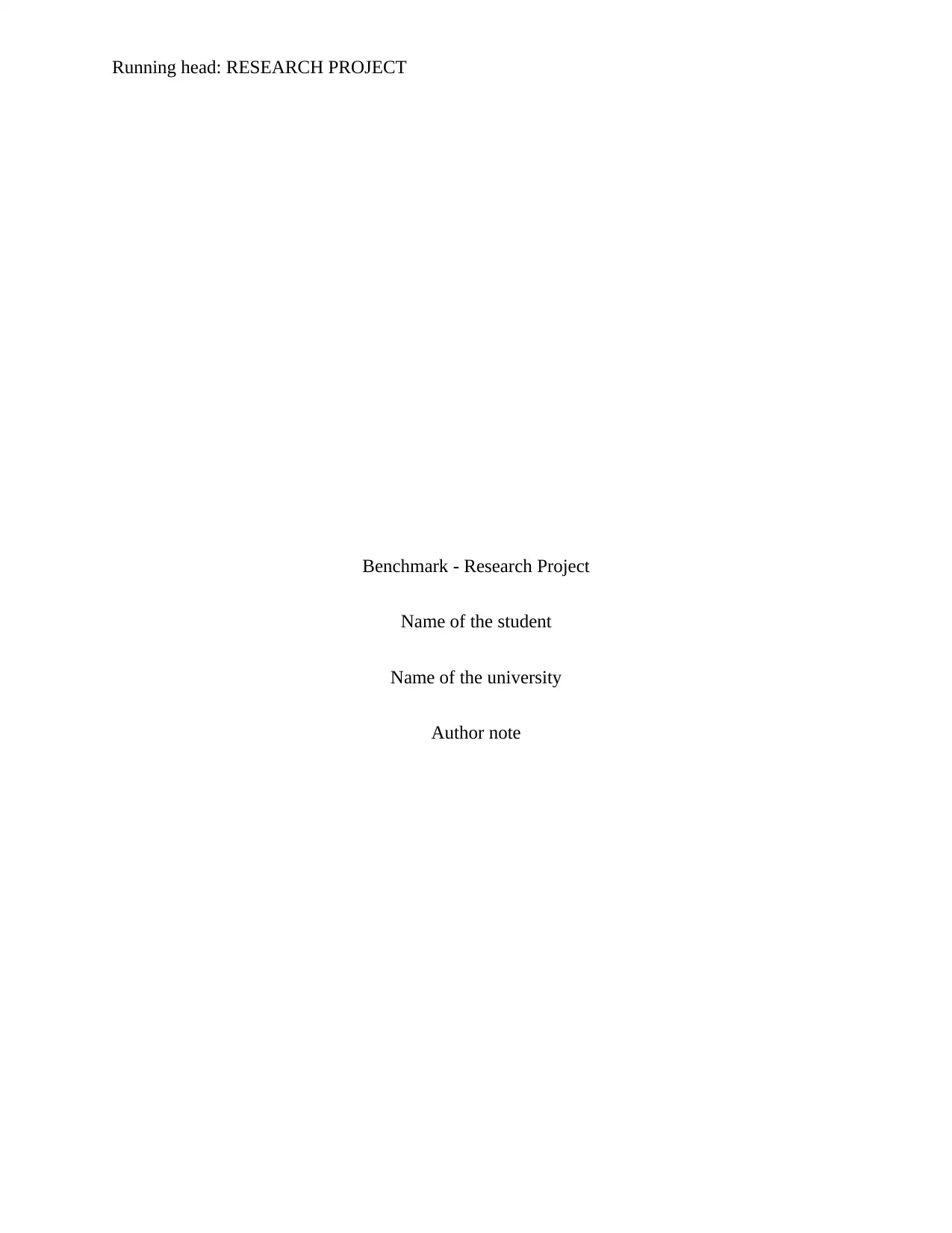
Running head: RESEARCH PROJECT
Benchmark - Research Project
Name of the student
Name of the university
Author note
Benchmark - Research Project
Name of the student
Name of the university
Author note
Paraphrase This Document
Need a fresh take? Get an instant paraphrase of this document with our AI Paraphraser
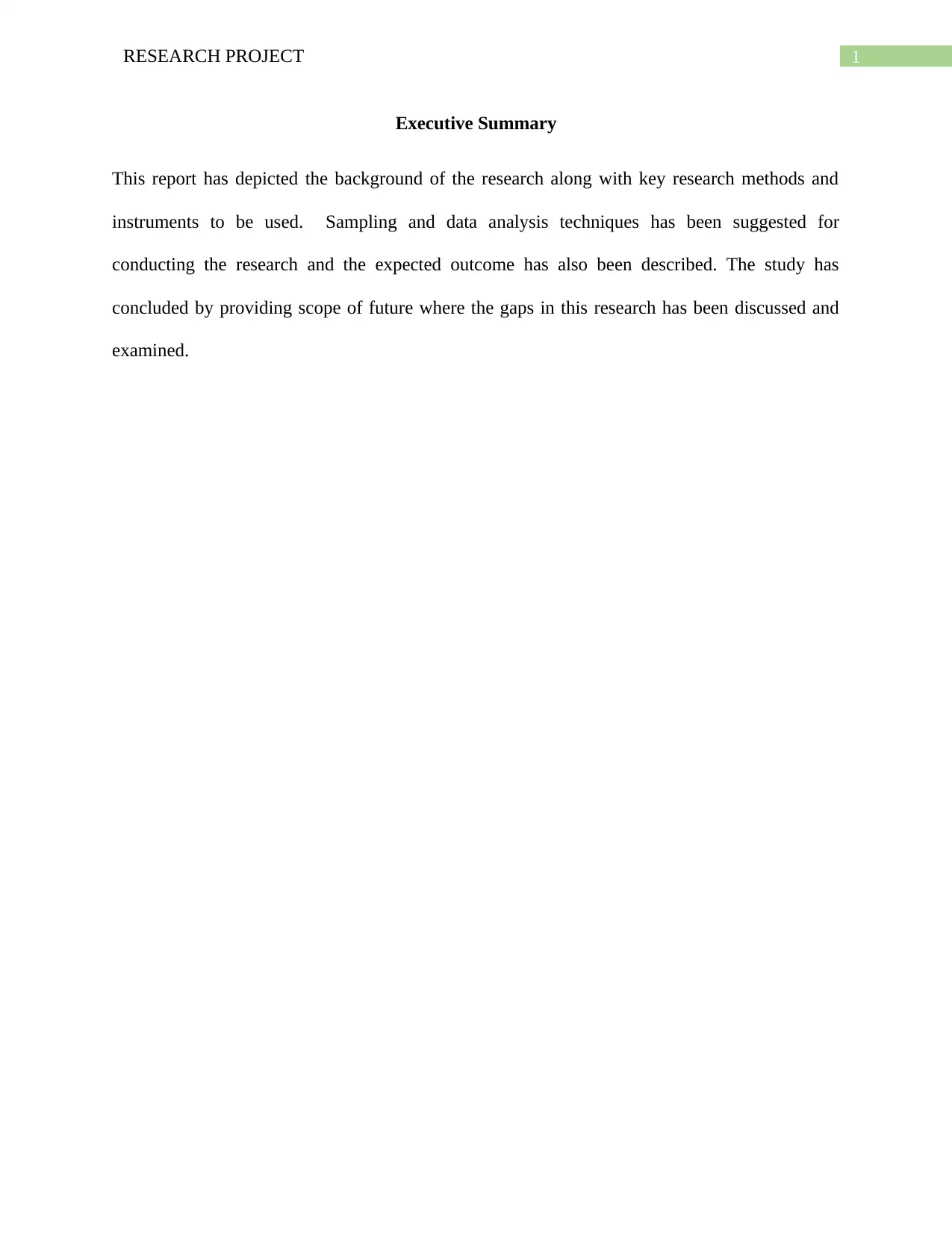
1RESEARCH PROJECT
Executive Summary
This report has depicted the background of the research along with key research methods and
instruments to be used. Sampling and data analysis techniques has been suggested for
conducting the research and the expected outcome has also been described. The study has
concluded by providing scope of future where the gaps in this research has been discussed and
examined.
Executive Summary
This report has depicted the background of the research along with key research methods and
instruments to be used. Sampling and data analysis techniques has been suggested for
conducting the research and the expected outcome has also been described. The study has
concluded by providing scope of future where the gaps in this research has been discussed and
examined.
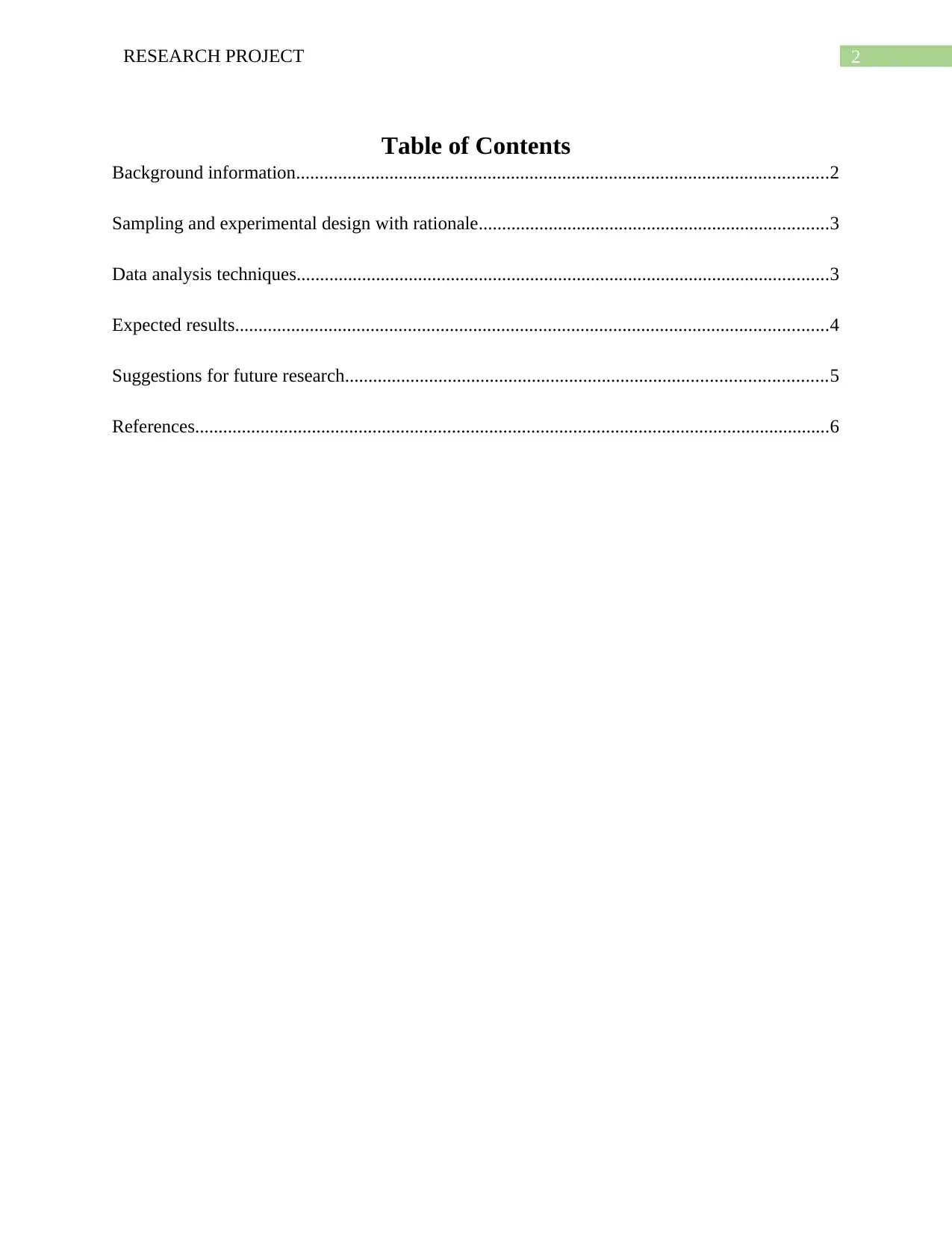
2RESEARCH PROJECT
Table of Contents
Background information..................................................................................................................2
Sampling and experimental design with rationale...........................................................................3
Data analysis techniques..................................................................................................................3
Expected results...............................................................................................................................4
Suggestions for future research.......................................................................................................5
References........................................................................................................................................6
Table of Contents
Background information..................................................................................................................2
Sampling and experimental design with rationale...........................................................................3
Data analysis techniques..................................................................................................................3
Expected results...............................................................................................................................4
Suggestions for future research.......................................................................................................5
References........................................................................................................................................6
⊘ This is a preview!⊘
Do you want full access?
Subscribe today to unlock all pages.

Trusted by 1+ million students worldwide
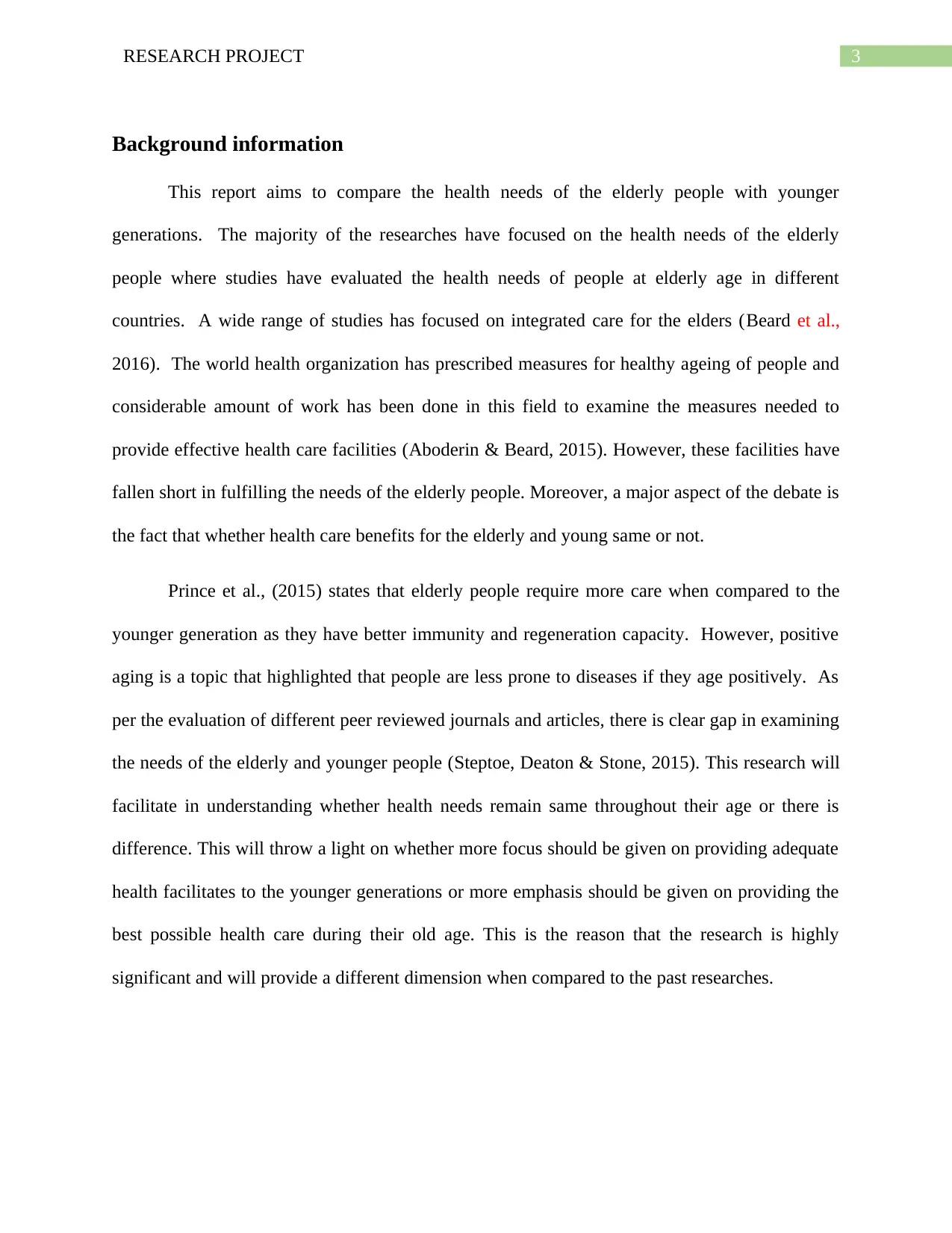
3RESEARCH PROJECT
Background information
This report aims to compare the health needs of the elderly people with younger
generations. The majority of the researches have focused on the health needs of the elderly
people where studies have evaluated the health needs of people at elderly age in different
countries. A wide range of studies has focused on integrated care for the elders (Beard et al.,
2016). The world health organization has prescribed measures for healthy ageing of people and
considerable amount of work has been done in this field to examine the measures needed to
provide effective health care facilities (Aboderin & Beard, 2015). However, these facilities have
fallen short in fulfilling the needs of the elderly people. Moreover, a major aspect of the debate is
the fact that whether health care benefits for the elderly and young same or not.
Prince et al., (2015) states that elderly people require more care when compared to the
younger generation as they have better immunity and regeneration capacity. However, positive
aging is a topic that highlighted that people are less prone to diseases if they age positively. As
per the evaluation of different peer reviewed journals and articles, there is clear gap in examining
the needs of the elderly and younger people (Steptoe, Deaton & Stone, 2015). This research will
facilitate in understanding whether health needs remain same throughout their age or there is
difference. This will throw a light on whether more focus should be given on providing adequate
health facilitates to the younger generations or more emphasis should be given on providing the
best possible health care during their old age. This is the reason that the research is highly
significant and will provide a different dimension when compared to the past researches.
Background information
This report aims to compare the health needs of the elderly people with younger
generations. The majority of the researches have focused on the health needs of the elderly
people where studies have evaluated the health needs of people at elderly age in different
countries. A wide range of studies has focused on integrated care for the elders (Beard et al.,
2016). The world health organization has prescribed measures for healthy ageing of people and
considerable amount of work has been done in this field to examine the measures needed to
provide effective health care facilities (Aboderin & Beard, 2015). However, these facilities have
fallen short in fulfilling the needs of the elderly people. Moreover, a major aspect of the debate is
the fact that whether health care benefits for the elderly and young same or not.
Prince et al., (2015) states that elderly people require more care when compared to the
younger generation as they have better immunity and regeneration capacity. However, positive
aging is a topic that highlighted that people are less prone to diseases if they age positively. As
per the evaluation of different peer reviewed journals and articles, there is clear gap in examining
the needs of the elderly and younger people (Steptoe, Deaton & Stone, 2015). This research will
facilitate in understanding whether health needs remain same throughout their age or there is
difference. This will throw a light on whether more focus should be given on providing adequate
health facilitates to the younger generations or more emphasis should be given on providing the
best possible health care during their old age. This is the reason that the research is highly
significant and will provide a different dimension when compared to the past researches.
Paraphrase This Document
Need a fresh take? Get an instant paraphrase of this document with our AI Paraphraser
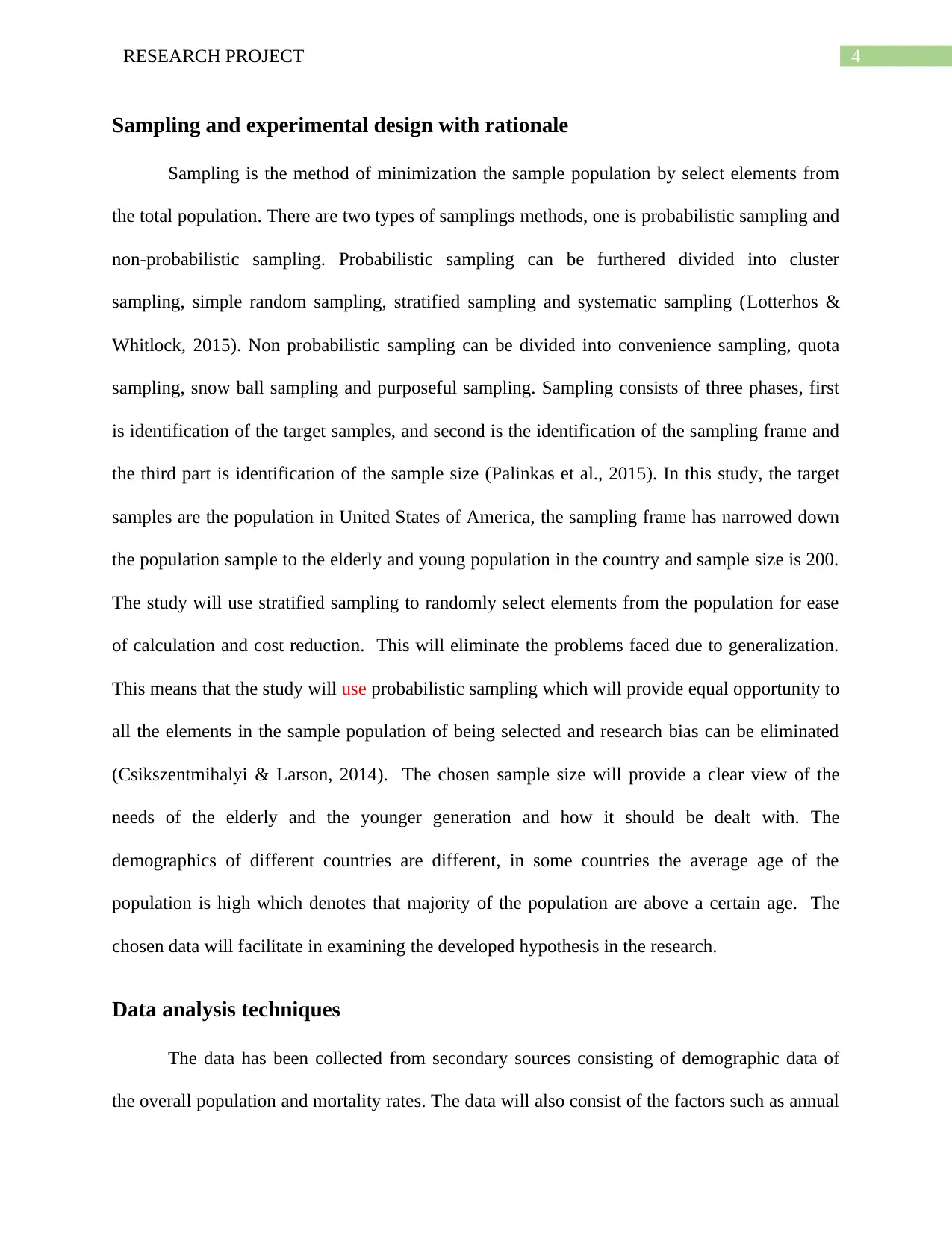
4RESEARCH PROJECT
Sampling and experimental design with rationale
Sampling is the method of minimization the sample population by select elements from
the total population. There are two types of samplings methods, one is probabilistic sampling and
non-probabilistic sampling. Probabilistic sampling can be furthered divided into cluster
sampling, simple random sampling, stratified sampling and systematic sampling (Lotterhos &
Whitlock, 2015). Non probabilistic sampling can be divided into convenience sampling, quota
sampling, snow ball sampling and purposeful sampling. Sampling consists of three phases, first
is identification of the target samples, and second is the identification of the sampling frame and
the third part is identification of the sample size (Palinkas et al., 2015). In this study, the target
samples are the population in United States of America, the sampling frame has narrowed down
the population sample to the elderly and young population in the country and sample size is 200.
The study will use stratified sampling to randomly select elements from the population for ease
of calculation and cost reduction. This will eliminate the problems faced due to generalization.
This means that the study will use probabilistic sampling which will provide equal opportunity to
all the elements in the sample population of being selected and research bias can be eliminated
(Csikszentmihalyi & Larson, 2014). The chosen sample size will provide a clear view of the
needs of the elderly and the younger generation and how it should be dealt with. The
demographics of different countries are different, in some countries the average age of the
population is high which denotes that majority of the population are above a certain age. The
chosen data will facilitate in examining the developed hypothesis in the research.
Data analysis techniques
The data has been collected from secondary sources consisting of demographic data of
the overall population and mortality rates. The data will also consist of the factors such as annual
Sampling and experimental design with rationale
Sampling is the method of minimization the sample population by select elements from
the total population. There are two types of samplings methods, one is probabilistic sampling and
non-probabilistic sampling. Probabilistic sampling can be furthered divided into cluster
sampling, simple random sampling, stratified sampling and systematic sampling (Lotterhos &
Whitlock, 2015). Non probabilistic sampling can be divided into convenience sampling, quota
sampling, snow ball sampling and purposeful sampling. Sampling consists of three phases, first
is identification of the target samples, and second is the identification of the sampling frame and
the third part is identification of the sample size (Palinkas et al., 2015). In this study, the target
samples are the population in United States of America, the sampling frame has narrowed down
the population sample to the elderly and young population in the country and sample size is 200.
The study will use stratified sampling to randomly select elements from the population for ease
of calculation and cost reduction. This will eliminate the problems faced due to generalization.
This means that the study will use probabilistic sampling which will provide equal opportunity to
all the elements in the sample population of being selected and research bias can be eliminated
(Csikszentmihalyi & Larson, 2014). The chosen sample size will provide a clear view of the
needs of the elderly and the younger generation and how it should be dealt with. The
demographics of different countries are different, in some countries the average age of the
population is high which denotes that majority of the population are above a certain age. The
chosen data will facilitate in examining the developed hypothesis in the research.
Data analysis techniques
The data has been collected from secondary sources consisting of demographic data of
the overall population and mortality rates. The data will also consist of the factors such as annual
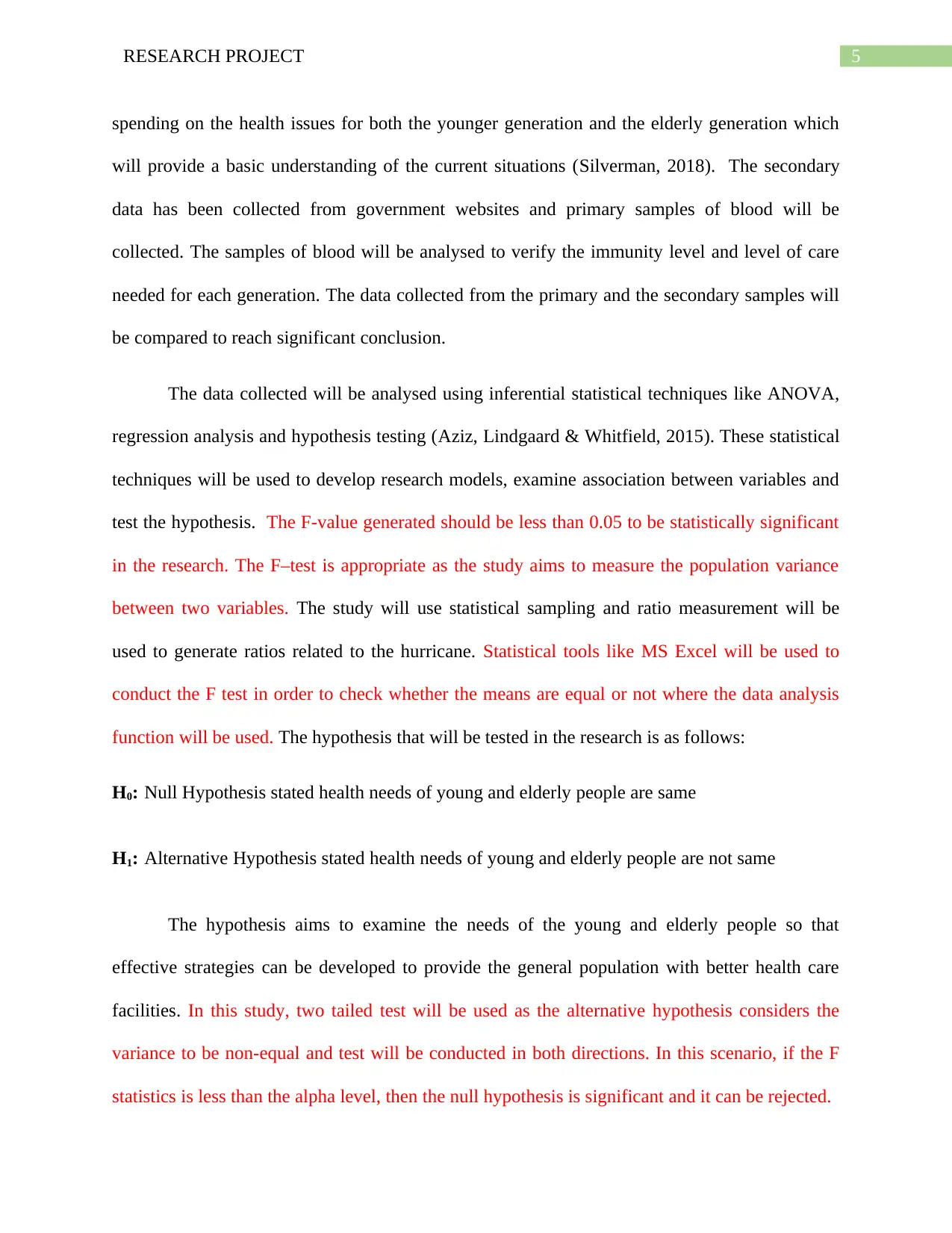
5RESEARCH PROJECT
spending on the health issues for both the younger generation and the elderly generation which
will provide a basic understanding of the current situations (Silverman, 2018). The secondary
data has been collected from government websites and primary samples of blood will be
collected. The samples of blood will be analysed to verify the immunity level and level of care
needed for each generation. The data collected from the primary and the secondary samples will
be compared to reach significant conclusion.
The data collected will be analysed using inferential statistical techniques like ANOVA,
regression analysis and hypothesis testing (Aziz, Lindgaard & Whitfield, 2015). These statistical
techniques will be used to develop research models, examine association between variables and
test the hypothesis. The F-value generated should be less than 0.05 to be statistically significant
in the research. The F–test is appropriate as the study aims to measure the population variance
between two variables. The study will use statistical sampling and ratio measurement will be
used to generate ratios related to the hurricane. Statistical tools like MS Excel will be used to
conduct the F test in order to check whether the means are equal or not where the data analysis
function will be used. The hypothesis that will be tested in the research is as follows:
H0: Null Hypothesis stated health needs of young and elderly people are same
H1: Alternative Hypothesis stated health needs of young and elderly people are not same
The hypothesis aims to examine the needs of the young and elderly people so that
effective strategies can be developed to provide the general population with better health care
facilities. In this study, two tailed test will be used as the alternative hypothesis considers the
variance to be non-equal and test will be conducted in both directions. In this scenario, if the F
statistics is less than the alpha level, then the null hypothesis is significant and it can be rejected.
spending on the health issues for both the younger generation and the elderly generation which
will provide a basic understanding of the current situations (Silverman, 2018). The secondary
data has been collected from government websites and primary samples of blood will be
collected. The samples of blood will be analysed to verify the immunity level and level of care
needed for each generation. The data collected from the primary and the secondary samples will
be compared to reach significant conclusion.
The data collected will be analysed using inferential statistical techniques like ANOVA,
regression analysis and hypothesis testing (Aziz, Lindgaard & Whitfield, 2015). These statistical
techniques will be used to develop research models, examine association between variables and
test the hypothesis. The F-value generated should be less than 0.05 to be statistically significant
in the research. The F–test is appropriate as the study aims to measure the population variance
between two variables. The study will use statistical sampling and ratio measurement will be
used to generate ratios related to the hurricane. Statistical tools like MS Excel will be used to
conduct the F test in order to check whether the means are equal or not where the data analysis
function will be used. The hypothesis that will be tested in the research is as follows:
H0: Null Hypothesis stated health needs of young and elderly people are same
H1: Alternative Hypothesis stated health needs of young and elderly people are not same
The hypothesis aims to examine the needs of the young and elderly people so that
effective strategies can be developed to provide the general population with better health care
facilities. In this study, two tailed test will be used as the alternative hypothesis considers the
variance to be non-equal and test will be conducted in both directions. In this scenario, if the F
statistics is less than the alpha level, then the null hypothesis is significant and it can be rejected.
⊘ This is a preview!⊘
Do you want full access?
Subscribe today to unlock all pages.

Trusted by 1+ million students worldwide
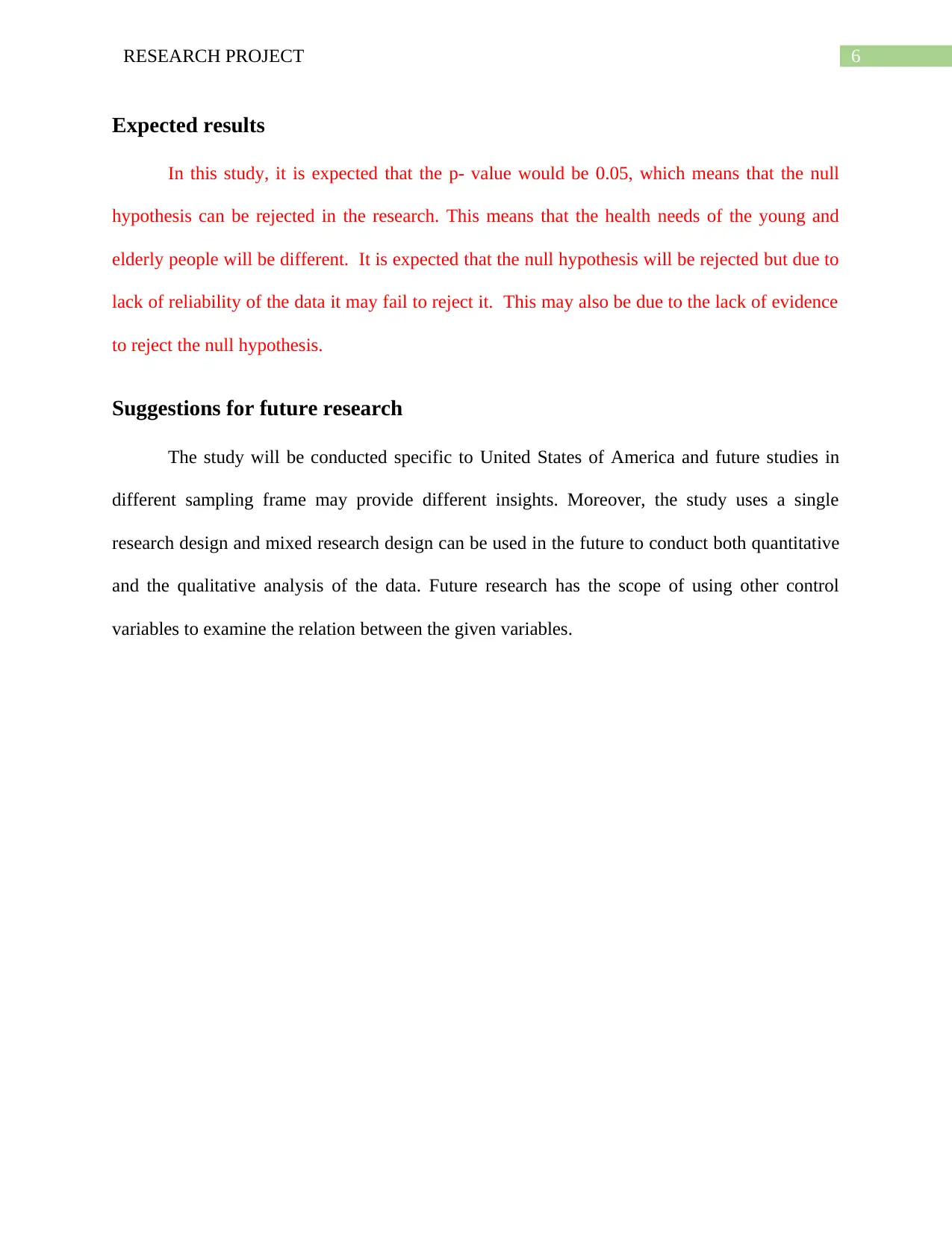
6RESEARCH PROJECT
Expected results
In this study, it is expected that the p- value would be 0.05, which means that the null
hypothesis can be rejected in the research. This means that the health needs of the young and
elderly people will be different. It is expected that the null hypothesis will be rejected but due to
lack of reliability of the data it may fail to reject it. This may also be due to the lack of evidence
to reject the null hypothesis.
Suggestions for future research
The study will be conducted specific to United States of America and future studies in
different sampling frame may provide different insights. Moreover, the study uses a single
research design and mixed research design can be used in the future to conduct both quantitative
and the qualitative analysis of the data. Future research has the scope of using other control
variables to examine the relation between the given variables.
Expected results
In this study, it is expected that the p- value would be 0.05, which means that the null
hypothesis can be rejected in the research. This means that the health needs of the young and
elderly people will be different. It is expected that the null hypothesis will be rejected but due to
lack of reliability of the data it may fail to reject it. This may also be due to the lack of evidence
to reject the null hypothesis.
Suggestions for future research
The study will be conducted specific to United States of America and future studies in
different sampling frame may provide different insights. Moreover, the study uses a single
research design and mixed research design can be used in the future to conduct both quantitative
and the qualitative analysis of the data. Future research has the scope of using other control
variables to examine the relation between the given variables.
Paraphrase This Document
Need a fresh take? Get an instant paraphrase of this document with our AI Paraphraser
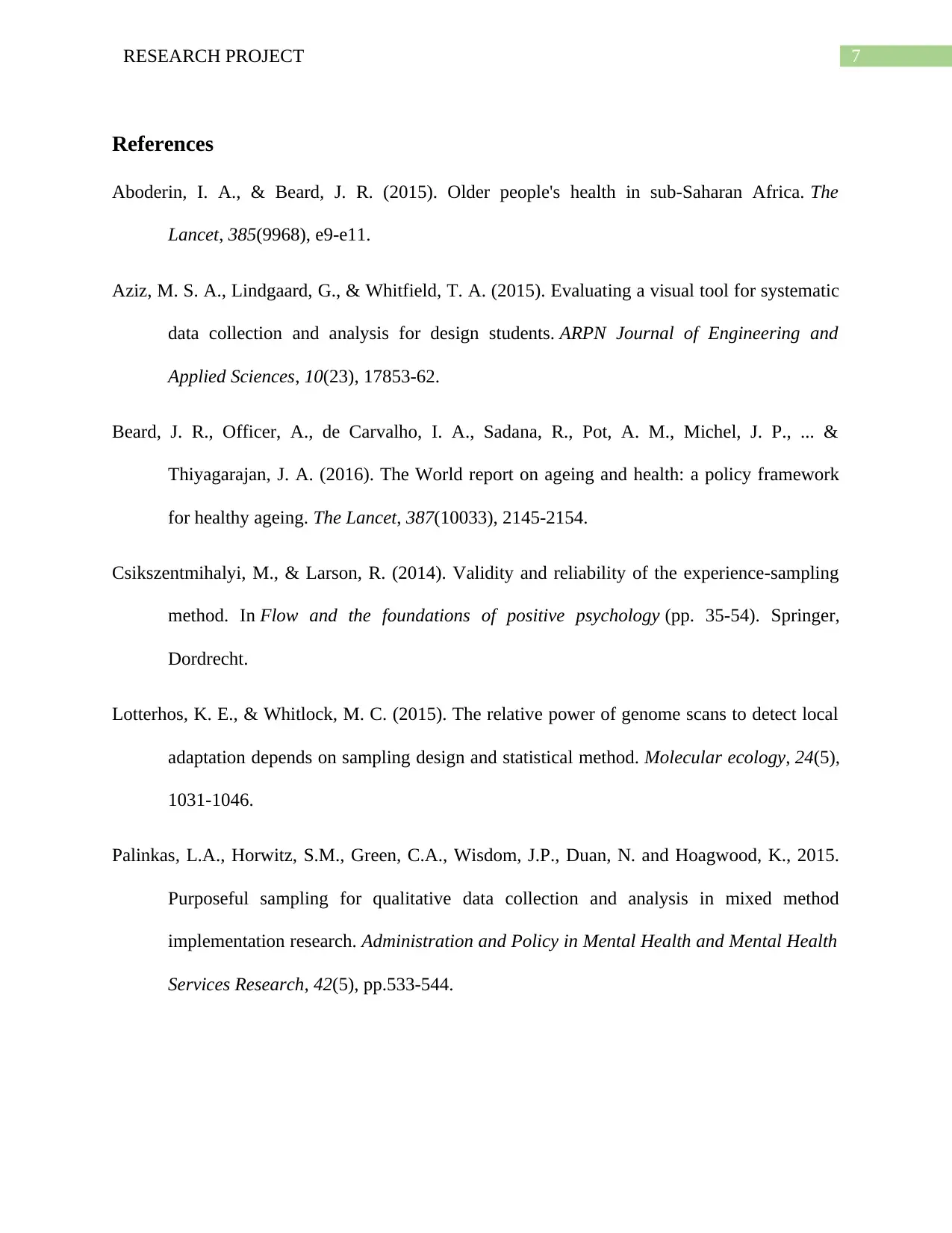
7RESEARCH PROJECT
References
Aboderin, I. A., & Beard, J. R. (2015). Older people's health in sub-Saharan Africa. The
Lancet, 385(9968), e9-e11.
Aziz, M. S. A., Lindgaard, G., & Whitfield, T. A. (2015). Evaluating a visual tool for systematic
data collection and analysis for design students. ARPN Journal of Engineering and
Applied Sciences, 10(23), 17853-62.
Beard, J. R., Officer, A., de Carvalho, I. A., Sadana, R., Pot, A. M., Michel, J. P., ... &
Thiyagarajan, J. A. (2016). The World report on ageing and health: a policy framework
for healthy ageing. The Lancet, 387(10033), 2145-2154.
Csikszentmihalyi, M., & Larson, R. (2014). Validity and reliability of the experience-sampling
method. In Flow and the foundations of positive psychology (pp. 35-54). Springer,
Dordrecht.
Lotterhos, K. E., & Whitlock, M. C. (2015). The relative power of genome scans to detect local
adaptation depends on sampling design and statistical method. Molecular ecology, 24(5),
1031-1046.
Palinkas, L.A., Horwitz, S.M., Green, C.A., Wisdom, J.P., Duan, N. and Hoagwood, K., 2015.
Purposeful sampling for qualitative data collection and analysis in mixed method
implementation research. Administration and Policy in Mental Health and Mental Health
Services Research, 42(5), pp.533-544.
References
Aboderin, I. A., & Beard, J. R. (2015). Older people's health in sub-Saharan Africa. The
Lancet, 385(9968), e9-e11.
Aziz, M. S. A., Lindgaard, G., & Whitfield, T. A. (2015). Evaluating a visual tool for systematic
data collection and analysis for design students. ARPN Journal of Engineering and
Applied Sciences, 10(23), 17853-62.
Beard, J. R., Officer, A., de Carvalho, I. A., Sadana, R., Pot, A. M., Michel, J. P., ... &
Thiyagarajan, J. A. (2016). The World report on ageing and health: a policy framework
for healthy ageing. The Lancet, 387(10033), 2145-2154.
Csikszentmihalyi, M., & Larson, R. (2014). Validity and reliability of the experience-sampling
method. In Flow and the foundations of positive psychology (pp. 35-54). Springer,
Dordrecht.
Lotterhos, K. E., & Whitlock, M. C. (2015). The relative power of genome scans to detect local
adaptation depends on sampling design and statistical method. Molecular ecology, 24(5),
1031-1046.
Palinkas, L.A., Horwitz, S.M., Green, C.A., Wisdom, J.P., Duan, N. and Hoagwood, K., 2015.
Purposeful sampling for qualitative data collection and analysis in mixed method
implementation research. Administration and Policy in Mental Health and Mental Health
Services Research, 42(5), pp.533-544.
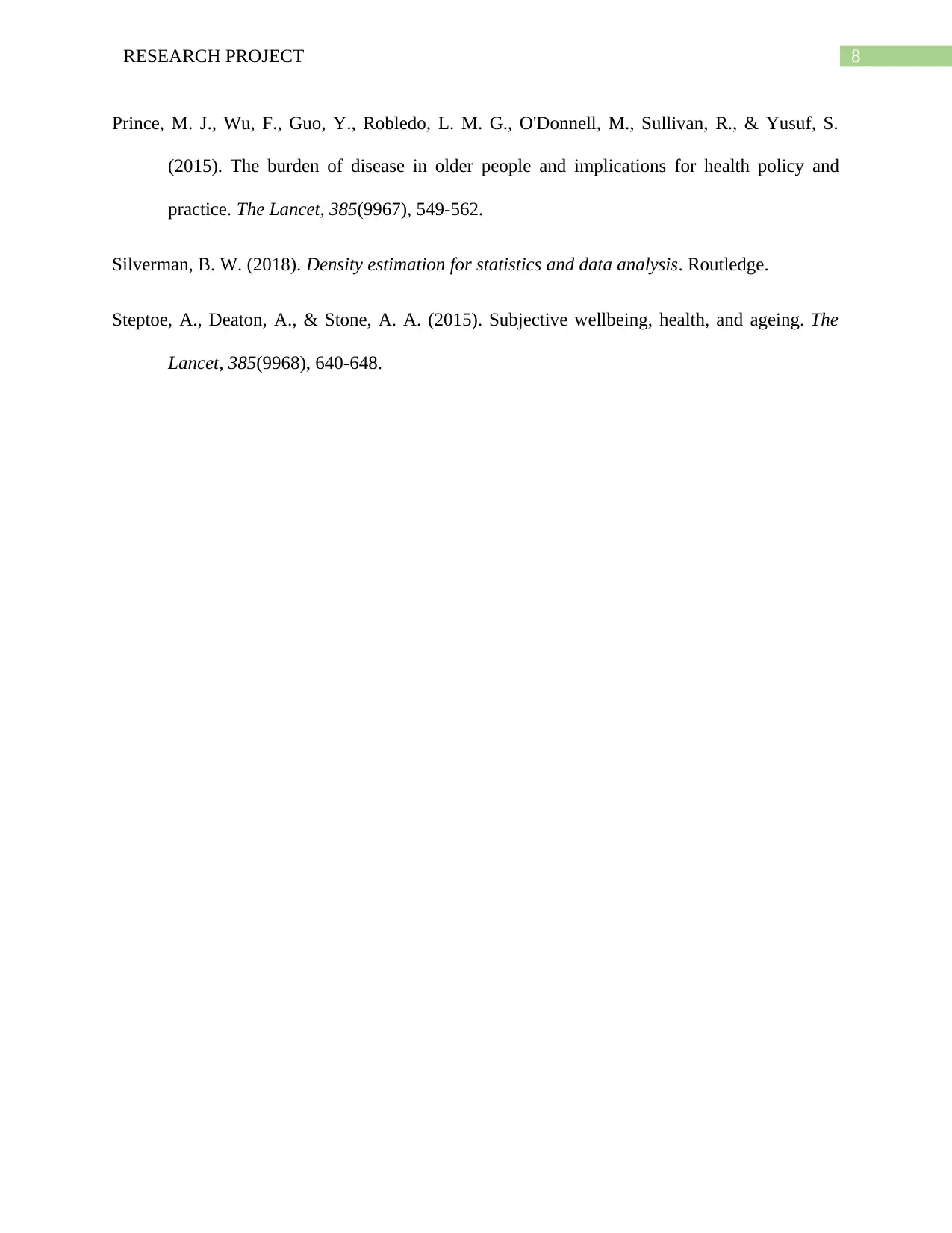
8RESEARCH PROJECT
Prince, M. J., Wu, F., Guo, Y., Robledo, L. M. G., O'Donnell, M., Sullivan, R., & Yusuf, S.
(2015). The burden of disease in older people and implications for health policy and
practice. The Lancet, 385(9967), 549-562.
Silverman, B. W. (2018). Density estimation for statistics and data analysis. Routledge.
Steptoe, A., Deaton, A., & Stone, A. A. (2015). Subjective wellbeing, health, and ageing. The
Lancet, 385(9968), 640-648.
Prince, M. J., Wu, F., Guo, Y., Robledo, L. M. G., O'Donnell, M., Sullivan, R., & Yusuf, S.
(2015). The burden of disease in older people and implications for health policy and
practice. The Lancet, 385(9967), 549-562.
Silverman, B. W. (2018). Density estimation for statistics and data analysis. Routledge.
Steptoe, A., Deaton, A., & Stone, A. A. (2015). Subjective wellbeing, health, and ageing. The
Lancet, 385(9968), 640-648.
⊘ This is a preview!⊘
Do you want full access?
Subscribe today to unlock all pages.

Trusted by 1+ million students worldwide
1 out of 9
Related Documents
Your All-in-One AI-Powered Toolkit for Academic Success.
+13062052269
info@desklib.com
Available 24*7 on WhatsApp / Email
![[object Object]](/_next/static/media/star-bottom.7253800d.svg)
Unlock your academic potential
Copyright © 2020–2025 A2Z Services. All Rights Reserved. Developed and managed by ZUCOL.





